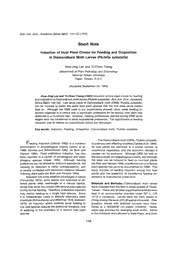
Induction of Host Plant Choice for Feeding and Oviposition in Diamondback Moth Larvae (Plutella xylostella) PDF
Preview Induction of Host Plant Choice for Feeding and Oviposition in Diamondback Moth Larvae (Plutella xylostella)
Bull. Inst. Zool., Academia Sinica ~2(2): 148-152 (1993) Short Note Induction of Host Plant Choice for Feeding and Oviposition in Diamondback Moth Larvae (Plutella xylostella) How-Jing Lee and Vi-Chien Tseng Department of Plant Pathology and Entomology National Taiwan University Taipei, Taiwan, R.O.C. (Accepted September 24, 1992) How-Jing Lee and Vi-Chien Tseng (1993) Induction of host plant choice for feeding and oviposition in Diamondback moth larvae (P/utel/a xy/ostel/a). Bull. Insf. Zoo/., Academia Sinica 32(2): 148-152. Last larval instar of Diamondback moth (DBM), Plutella xylostella, can be induced to prefer the same host plant species that the first three larval instars feed on. Although the DBM used in our experiments showed rather weak feeding in duction response in a choice test, a significant preference for its familiar host plant was observed in a no-choice test. However, feeding preferences learned during DBM larval stages were not transferred to adult ovipositional preference. The significance of feeding induction and its effects on ovipositional choice are discussed. Key words: Induction, Feeding, Oviposition, Diamondback moth, Plutella xylostella. The Diamondback moth (DBM), Plutella xylostella, Feeding induction (Dethier 1982) is a common is a serious pest affecting crucifers,(Talekar et al. 1985). phenomenon in phytophagous insects (Jermy et al. Its host plants are restricted to a limited number of 1968, Saxena and Schoon hoven 1982, de Boer and cruciferous vegetables, and the economic damage it Hanson 1984). Food preference induction ha~ also causes can be extensive. Although. DBM (as well as been repor):edin a variety of polyphagous and oligo Manduca sexta) are oligophagous insects, and although phagous species (Hsiao 1985). Although feeding the latter can be induced to feed on non-host plants preference can be altered by previous experience, the (de Boer and Hanson 1984), a preferred non-cruciferous capacity for induction is rather species-specific, and plant species has yet to be documented for DBM. This is usually correlated with taxonomic distance between study focuses on feeding induction among four host inducing plant pairs (de Boer and Hanson 1984). plants and the possibility of transferring feeding ex Induction has some adaptive advantages in nature perience to ovipositional preference. (Yamamoto 1974); since leaves and branches of dif ferent plants often intermingle in a natural habitat, Materials and Methods-Diamondback moth larvae larvae may come into contact with several plant species were collected from the field in areas outside of Taipei, during normal feeding. Therefore, preference induction Taiwan. These and all other experimental animals were may restrict feeding to a single host species. Since kept in an environmental chamber under 23° C, UD it is metabolically costly to detoxify secondary plant 12: 12 h conditions. Larvae were fed fresh leaves of chemicals (Schoon hoven and Meerman 1978, Brattsten Ching-chiang Pai-tecei (CP) (Brassica chinensis). After 1979), an induction which conftnes larval feeding to pupation, leaves with attached cocoons were trans one host species reduces the additional metabolic cost ferred to a 30X30X30 cm plastic container. Honey of adapting to the chemistry of a second host plant water was provided for emerging adult moths. Adults species. in the container were allowed to mate freely, and fresh 148
